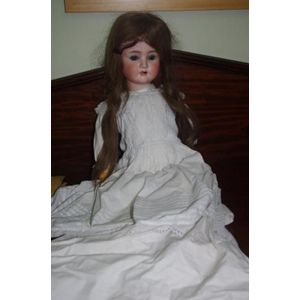Japanese Kutani Sake Tokkuri Pair, Taisho Period
A pair of Japanese Kutani sake Tokkuri, Taisho period (1912-1926), the two ovoid flasks of mostly unglazed stoneware with incised spiral rings running the full length, the front decorated with abstracted vine and leaf motif in silver and gilding, the interior glazed with a creamy grey glaze, splashing out and over the mouth and neck. The base of each with a painted iron-red four-character mark 'Kutani.......' (partly unread). Together with signed tomobako (original box). Each 13.5 cm high, 6.5 cm diameter,
You must be a subscriber, and be logged in to view price and dealer details.
Subscribe Now to view actual auction price for this item
When you subscribe, you have the option of setting the currency in which to display prices to $Au, $US, $NZ or Stg.
This item has been sold, and the description, image and price are for reference purposes only.
- Gilding - Gilding is a method of ornamentation whereby a thin sheet of gold metal is applied to items made of wood, leather, ceramics, glass and silver for decorative purposes.
For furniture including mirrors, the sheet of gold is usually applied over a coating of gesso. Gesso is a mixture of plaster of Paris and gypsum mixed with water and then applied to the carved wooden frames of mirrors and picture frames as a base for applying the gold leaf. After numerous coats of gesso have been applied, allowed to dry and then sanded a coat of "bole", a usually red coloured mixture of clay and glue is brushed on and allowed to dry, after which the gold leaf is applied. Over time parts of the gilding will rub off so the base colour can be seen. In water gilding, this was generally a blue colour, while in oil gilding, the under layer was often yellow. In Victorian times, gilders frequently used red as a pigment beneath the gold leaf.
Metal was often gilded by a process known as fire gilding. Gold mixed with mercury was applied and heated, causing the mercury to evaporate, the long-term effect of which was to kill or disable the craftsman or woman from mercury poisoning. The pursuit of beauty has claimed many victims, not the least of which were the artists who made those pieces so highly sought after today. - Oviform /ovoid - The outline loosely resembling the shape of an egg.
- Incised - A record of a name, date or inscription, or a decoration scratched into a surface, usually of a glass or ceramic item with a blunt instrument to make a coarse indentation. Compare with engraving where the surface is cut with a sharp instrument such as a metal needle or rotating tool to achieve a fine indentation.
This item has been included into following indexes:
- oriental objects - boxes 1,766
Visually similar items

Large antique Max Handwerck doll, in vintage clothing. Marked on neck. No 1/2. as inspected. 76 cm
Sold by
in
for
You can display prices in $Au, $US, $NZ or Stg.

Bronze figure, William Shakespeare resting on a branch, by George Dudley, April 23rd 1822
Sold by
in
for
You can display prices in $Au, $US, $NZ or Stg.

Vintage 14ct gold bracelet (filled), weight: approx 3.43 grams
Sold by
in
for
You can display prices in $Au, $US, $NZ or Stg.

Two Australian medallions, comprising cased Bicentenary medallion and cased Canberra medallion, (2)
Sold by
in
for
You can display prices in $Au, $US, $NZ or Stg.
